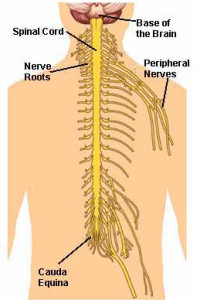Sciatica, Peripheral Neuropathy
The sciatic nerve is the longest and largest nerve in the body; it measures three-quarters of an inch in diameter. It originates in the sacral plexus; a network of nerves in the low back (lumbosacral spine). The lumbosacral spine refers to the lumbar spine and the sacrum combined. The sciatic nerve and its nerve branches enable movement and feeling (motor and sensory functions) in the thigh, knee, calf, ankle, foot, and toes. The sciatic nerve and the lumbosacral spine is pictured below.
Sciatic Nerve
If the sciatic nerve is injured or becomes inflamed, it causes symptoms called sciatica, which can cause intense pain along any part of the sciatic nerve pathway, from the buttocks to the toes. These symptoms can also be called lumbar radiculopathy, so you may hear your doctor use that term.
If the nerve is compressed, caused by conditions such as a herniated disc or spinal stenosis, symptoms may include a loss of reflexes, weakness and numbness besides severe pain. Sciatic nerve pain can make everyday activities such as walking, sitting and standing difficult.
The sciatic nerve starts in your low back, which is called your lumbar spine. The nerve roots are at the L4 and L5 vertebrae (the ‘L’ means lumbar, and the numbers indicate the level of the vertebra—where it is in your back). The sciatic nerve also travels through your pelvic region (sacrum).
In most people, the sciatic nerve runs under the piriformis muscle, which moves your thigh side to side. From there, the sciatic nerve descends through the buttocks and the back of the thighs. Behind your knee, smaller nerves branch out from the sciatic nerve and travel down to your feet.
Your sciatic nerve is part of a complex structure: your body’s nervous system. That system is responsible for transmitting pain and sensation to other parts of your body. So, when something presses on a nerve, you’ll feel it, and it won’t feel good. With sciatica, something in your low back—a herniated disc, for example—compresses the sciatic nerve, which then transmits pain down your legs.
Spinal cord and nerve structures
The sciatic nerve exits the sacrum (pelvic area) through a nerve passageway called the sciatic foramen. At the upper part of the sciatic nerve, two branches form; the articular and muscular branches. The articular branch goes to the hip joint. The muscular branch serves the leg flexor muscles (muscles that enable movement).
Other complex nerve structures are involved—the peroneal nerves and tibial nerves. The peroneal nerves originate from the nerve roots at the fourth and fifth lumbar spine (L4-L5) and first and second levels of the sacrum (S1-2). After the peroneal nerves leave the pelvis, they travel down the front and side of the leg, and along the outer side of the knee, to the foot.
The tibial nerves originate from the nerve roots at L4-5 and S1-3. The tibial nerves pass in front of the knee and downward into the foot (heel, sole, toes).
If your sciatic nerve is compressed, it can cause pain along these pathways; that is how sciatic pain can “spread” or radiate to another part of your body.
